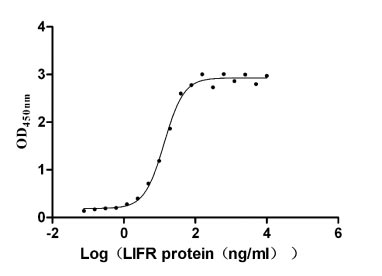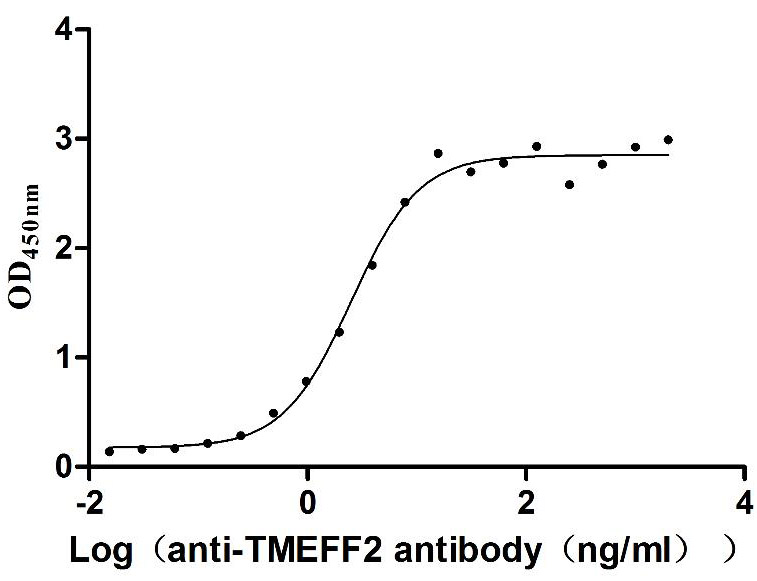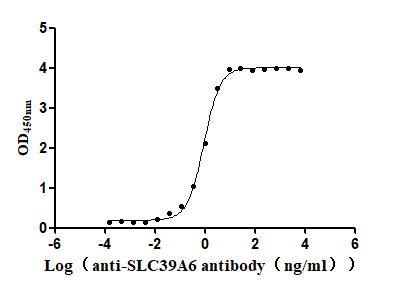Recombinant Dog Transforming growth factor beta-1 proprotein (TGFB1), partial
-
货号:CSB-YP023446DO
-
规格:
-
来源:Yeast
-
其他:
-
货号:CSB-EP023446DO
-
规格:
-
来源:E.coli
-
其他:
-
货号:CSB-EP023446DO-B
-
规格:
-
来源:E.coli
-
共轭:Avi-tag Biotinylated
E. coli biotin ligase (BirA) is highly specific in covalently attaching biotin to the 15 amino acid AviTag peptide. This recombinant protein was biotinylated in vivo by AviTag-BirA technology, which method is BriA catalyzes amide linkage between the biotin and the specific lysine of the AviTag.
-
其他:
-
货号:CSB-BP023446DO
-
规格:
-
来源:Baculovirus
-
其他:
-
货号:CSB-MP023446DO
-
规格:
-
来源:Mammalian cell
-
其他:
产品详情
-
纯度:>85% (SDS-PAGE)
-
基因名:
-
Uniprot No.:
-
别名:TGFB1; Transforming growth factor beta-1 proprotein [Cleaved into: Latency-associated peptide; LAP); Transforming growth factor beta-1; TGF-beta-1)]
-
种属:Canis familiaris (Dog) (Canis lupus familiaris)
-
蛋白长度:Partial
-
表达区域:279-390
-
氨基酸序列ALDTNYCFSSTEKNCCVRQLYIDFRKDLGWKWIHEPKGYHANFCLGPCPYIWSLDTQYSKVLALYNQHNPGASAAPCCVPQALEPLPIVYYVGRKPKVEQLSNMIVRSCKCS
-
蛋白标签:Tag type will be determined during the manufacturing process.
The tag type will be determined during production process. If you have specified tag type, please tell us and we will develop the specified tag preferentially. -
产品提供形式:Lyophilized powder
Note: We will preferentially ship the format that we have in stock, however, if you have any special requirement for the format, please remark your requirement when placing the order, we will prepare according to your demand. -
复溶:We recommend that this vial be briefly centrifuged prior to opening to bring the contents to the bottom. Please reconstitute protein in deionized sterile water to a concentration of 0.1-1.0 mg/mL.We recommend to add 5-50% of glycerol (final concentration) and aliquot for long-term storage at -20℃/-80℃. Our default final concentration of glycerol is 50%. Customers could use it as reference.
-
储存条件:Store at -20°C/-80°C upon receipt, aliquoting is necessary for mutiple use. Avoid repeated freeze-thaw cycles.
-
保质期:The shelf life is related to many factors, storage state, buffer ingredients, storage temperature and the stability of the protein itself.
Generally, the shelf life of liquid form is 6 months at -20°C/-80°C. The shelf life of lyophilized form is 12 months at -20°C/-80°C. -
货期:Delivery time may differ from different purchasing way or location, please kindly consult your local distributors for specific delivery time.Note: All of our proteins are default shipped with normal blue ice packs, if you request to ship with dry ice, please communicate with us in advance and extra fees will be charged.
-
注意事项:Repeated freezing and thawing is not recommended. Store working aliquots at 4°C for up to one week.
-
Datasheet :Please contact us to get it.
相关产品
靶点详情
-
功能:Transforming growth factor beta-1 proprotein: Precursor of the Latency-associated peptide (LAP) and Transforming growth factor beta-1 (TGF-beta-1) chains, which constitute the regulatory and active subunit of TGF-beta-1, respectively.; Required to maintain the Transforming growth factor beta-1 (TGF-beta-1) chain in a latent state during storage in extracellular matrix. Associates non-covalently with TGF-beta-1 and regulates its activation via interaction with 'milieu molecules', such as LTBP1, LRRC32/GARP and LRRC33/NRROS, that control activatio...显示更多
-
基因功能参考文献:
- Results suggested that CD61 (integrin-beta3) could induce canine adipose-derived mesenchymal stem cells (cADMSCs) to differentiate into primordial germ cell (PGC)-like cells by relying on the activation of transforming growth factor beta (TGF-beta) pathway. PMID: 28256590
- obstructive sleep apnea can accelerate the progression of pulmonary remodeling through TGF-beta/miR-185/CoLA1 signaling PMID: 27542203
- TGFbeta1 signaling through the canonical SMAD pathway is increased in myxomatous mitral valves, but does not apparently mediate interstitial cell apoptosis in canine MMVD. PMID: 23816827
- IL-6 markedly decreased the nuclear concentration of a TGF-beta signaling transducer, Smad 2/3. PMID: 23579028
- celastrol downregulates Snail expression, thereby inhibiting TGF-beta1-induced EMT in MDCK and A549 cells PMID: 23850675
- Ostectomy healing with or without platelet-rich plasma as indicated by radiography and expression of PDGF and TGF-beta expression are reported. PMID: 23111655
- This study tested the hypothesis that cyclic strain and TGFbeta1 interact to modify mitral valve interstitial cell phenotype in 3D culture. PMID: 22386586
- PAK2 negatively modulate TGF-beta signaling by attenuating the receptor-Smad interaction and thus Smad activation PMID: 22393057
- This study showed a lack of an effect of recombinant inteferon-gamma on transforming growth factor-beta (TGF-beta) expression in keratinocytes. PMID: 20860556
- Wnt-5a is involved during oncogenic H-Ras/TGF-beta-mediated epithelial-mesenchymal transition PMID: 20511395
- These results show basolateral domain specificity in localization of the TGFbeta receptor signaling apparatus. PMID: 20432436
- These findings suggest that polyunsaturated fatty acids are able to influence proliferation of peripheral blood mononuclear cells in healthy and atopic dogs but do not seem to influence cytokine transcription. PMID: 20187917
- Transforming growth factor-beta 1 secreted by canine transmissible venereal tumor cells suppresses lymphokine-activated killer cytotoxicity. PMID: 14734728
- role played by TGF-beta in mediating the cyclosporine-induced activation of ERK1/2 and the resulting increase in transepithelial electric resistance PMID: 17460148
- TGFbeta1 might be associated with pulmonary vein stenosis after radiofrequency ablation in chronic atrial fibrillation of dogs PMID: 17972164
收起更多
-
亚细胞定位:[Latency-associated peptide]: Secreted, extracellular space, extracellular matrix.; [Transforming growth factor beta-1]: Secreted.
-
蛋白家族:TGF-beta family
-
数据库链接:
KEGG: cfa:403998
STRING: 9615.ENSCAFP00000007462
UniGene: Cfa.3509




















